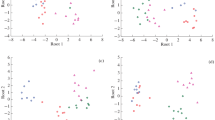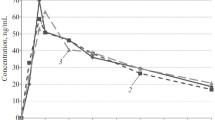Summary
(1.) The purpose of this study was to investigate the role of neuronal uptake in the appearance in plasma of the primary noradrenaline metabolite 3,4-dihydroxyphenylglycol (DOPEG). To this end, steady-state changes in mixed central-venous plasma concentrations of noradrenaline and DOPEG produced by noradrenaline infusions or by changes in sympathetic tone were determined in anaesthetized rabbits either under control conditions or after treatment with desipramine (2 mg kg−1). The steady-state kinetics of infused DOPEG were also evaluated. (2.) Infused DOPEG (2.9 nmol kg−1 min−1 i.v. for 75 min) reached steady-state concentrations in plasma within less than 30 min, disappeared from plasma with a half-life of 2.3 min and showed a total-body plasma clearance of 84.0 ml kg−1 min−1 (3.) Constant-rate infusions of noradrenaline (1.2–5.9 nmol kg−1). (min−1 i.v. for 75 min) produced increases in plasma noradrenaline and DOPEG concentrations which were linearly related to the rate of noradrenaline infusion. Thus, the plasma clearance of infused noradrenaline (75.8 ml kg−1). min−1 as well as the increase in plasma DOPEG expressed in % of that in plasma noradrenaline (9.4%) was virtually independent of the noradrenaline infusion rate. (4.) Desipramine reduced the plasma clearance of infused noradrenaline by 35.4% and the increment in plasma DOPEG relative to that in plasma noradrenaline by 75.3%. From these results and the plasma clearance of noradrenaline and DOPEG it was calculated that the rate at which presynaptically formed DOPEG appeared in plasma amounted to 7.9% of the rate of total noradrenaline removal and to 22.3% of the rate of neuronal uptake. (5.) The rate of appearance in plasma of DOPEG originating from the neuronal re-uptake of endogenous noradrenaline was 192.3 pmol (kg−1). min−1 suggesting that the rate of neuronal re-uptake amounted to 862.3 pmol (kg−1) min−1 (6.) The slope of the regression line relating plasma DOPEG to plasma noradrenaline concentrations under conditions of noradrenaline release exceeded that of the corresponding regression line observed during noradrenaline infusion by a factor of about 10. This difference in slope suggests that, in the absence of infused noradrenaline, the average noradrenaline concentration at all noradrenergic neuroeffector junctions of the rabbit is 3.2 times as high as that in plasma.
Similar content being viewed by others
References
Eisenhofer G, Ropchak TG, Stull RW, Goldstein DS, Keiser HR, Kopin IJ (1987) Dihydroxyphenylglycol and intraneuronal metabolism of endogenous and exogenous norepinephrine in the rat vas deferens. J Pharmacol Exp Ther 241:547–553
Eisenhofer G, Goldstein DS, Kopin IJ (1989) Plasma dihydroxyphenylglycol for estimation of noradrenaline neuronal re-uptake in the sympathetic nervous system in vivo. Clin Sci 76:171–182
Esler M, Jackman G, Leonard P, Skews H, Bobik A, Korner P (1981) Effect of norepinephrine uptake blockers on norepinephrine kinetics. Clin Pharmacol Ther 29:12–20
Goldstein DS, Horwitz D, Keiser HR, Polinsky RJ, Kopin IJ (1983) Plasma 1-3H-norepinephrine, d-14C-norepinephrine, and d-13H-isoproterenol kinetics in essential hypertension. J Clin Invest 72:1748–1758
Goldstein DS, Eisenhofer G, Stull R, Folio CJ, Keiser HR, Kopin IJ (1988) Plasma dihydroxyphenylglycol and the intraneuronal disposition of norepinephrine in humans. J Clin Invest 81:213–220
Graefe K-H, Henseling M (1983) Neuronal and extraneuronal uptake and metabolism of catecbolamines. Gen Pharmacol 14:27–33
Graefe K-H, Bönisch H (1988) The transport of amines across the axonal membrane of noradrenergic and dopaminergic neurones. In: Trendelenburg U, Weiner N (eds) Handbook of Exp Pharmacol (vol 90), Catecholamines I. Springer, Berlin Heidelberg New York Tokyo, pp 193–245
Halbrügge T, Ungell A-L, Wölfel R, Graefe K-H (1988a) Total body, systemic and pulmonary clearance and fractional extraction of unlabelled and differently 3H-labelled noradrenaline in the anaesthetized rabbit. Naunyn-Schmiedeberg's Arch Pharmacol 338:361–367
Halbrügge T, Gerhardt T, Ludwig J, Heidbreder E, Graefe K-H (1988b) Assay of catecholamines and dihydroxyphenylethyleneglycol in human plasma and its application in orthostasis and mental stress. Life Sci 43:19–26
Halbrügge T, Wölfel R (1989) Estimation of the noradrenaline concentration difference between plasma and noradrenergic neuroeffector junctions in the anaesthetized rabbit. Naunyn-Schmiedeberg's Arch Pharmacol 339 (Suppl):R87
Henseling M, Eckert E, Trendelenburg U (1976) The distribution of 3H-(±)-noradrenaline in rabbit aortic strips after inhibition of the noradrenaline-metabolizing enzymes. Naunyn-Schmiedeberg's Arch Pharmacol 292:205–217
Kopin IJ (1985) Catecholamine metabolism: basic aspects and clinical significance. Pharmacol Rev 37:333–364
Kopin IJ, Zukowska-Grojec Z, Bayorh MA, Goldstein DS (1984) Estimation of intrasynaptic norepinephrine concentrations at vascular neuroeffector junction in vivo. Naunyn-Schmiedeberg's Arch Pharmacol 325:298–305
Langer SZ, Farah MB, Luchelli-Fortis MA, Adler-Graschinsky E, Filinger EJ (1975) Metabolism of endogenous noradrenaline. In: Tuomisto J, Paasonen MK (eds) Proc. of the 6th International Congress of Pharmacology, vol 2. Helsinki, pp 17–31
Ludwig J, Gerhardt T, Halbrügge T, Walter J, Graefe K-H (1988) Plasma concentrations of noradrenaline and 3,4-dihydroxyphenylethyleneglycol under conditions of enhanced sympathetic activity. Eur J Clin Pharmacol 35:261–267
Majewski H, Hedler L, Starke K (1982) The noradrenaline release rate in the anaesthetized rabbit: facilitation by adrenaline. Naunyn-Schmiedeberg's Arch Pharmacol 321:20–27
Majewski H, Hedler L, Starke K (1983 a) Evidence for a physiological role of presynaptic a-adrenoceptors: modulation of noradrenaline release in the pithed rabbit. Naunyn-Schmiedeberg's Arch Pharmacol 324:256–263
Majewski H, Hedler L, Starke K (1983 b) Modulation of noradrenaline release in the conscious rabbit through α-adrenoceptors. Eur J Pharmacol 93:255–264
Sachs L (1984) Angewandte Statistik. Springer, Berlin Heidelberg New York Tokyo
Author information
Authors and Affiliations
Additional information
This study was supported by the Deutsche Forschungsgemeinscbaft (Gr 490/5). A preliminary account of the present results was presented to the German Pharmacological Society (Halbragge and Wölfel 1989)
Send offprint requests to T. Halbragge at the above address
Rights and permissions
About this article
Cite this article
Halbrügge, T., Wölfel, R. & Graefe, KH. Plasma 3,4-dihydroxyphenylglycol as a tool to assess the role of neuronal uptake in the anaesthetized rabbit. Naunyn-Schmiedeberg's Arch Pharmacol 340, 726–732 (1989). https://doi.org/10.1007/BF00169681
Received:
Accepted:
Issue Date:
DOI: https://doi.org/10.1007/BF00169681




